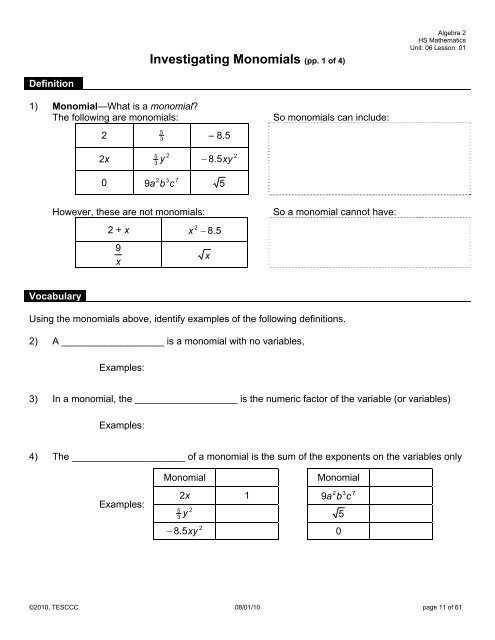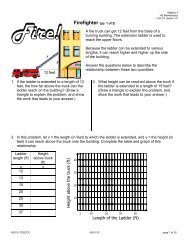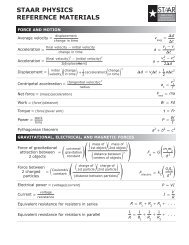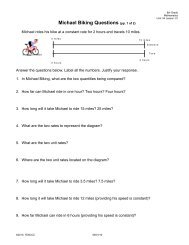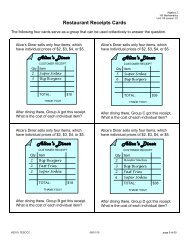Investigating Monomials (pp. 1 of 4)
Investigating Monomials (pp. 1 of 4)
Investigating Monomials (pp. 1 of 4)
Create successful ePaper yourself
Turn your PDF publications into a flip-book with our unique Google optimized e-Paper software.
<strong>Investigating</strong> <strong>Monomials</strong> (<strong>pp</strong>. 1 <strong>of</strong> 4)<br />
Algebra 2<br />
HS Mathematics<br />
Unit: 06 Lesson: 01<br />
Definition<br />
1) Monomial—What is a monomial?<br />
The following are monomials:<br />
5<br />
2 3 – 8.5<br />
So monomials can include:<br />
2x<br />
5 2<br />
y<br />
3<br />
8.5xy<br />
2<br />
2 3 7<br />
0<br />
9a b c 5<br />
However, these are not monomials:<br />
So a monomial cannot have:<br />
2 + x x<br />
2 8. 5<br />
9<br />
x<br />
x<br />
Vocabulary<br />
Using the monomials above, identify examples <strong>of</strong> the following definitions.<br />
2) A ___________________ is a monomial with no variables,<br />
Examples:<br />
3) In a monomial, the ___________________ is the numeric factor <strong>of</strong> the variable (or variables)<br />
Examples:<br />
4) The _____________________ <strong>of</strong> a monomial is the sum <strong>of</strong> the exponents on the variables only<br />
Monomial<br />
Monomial<br />
Examples:<br />
2 3 7<br />
2x 1 9a<br />
b c<br />
3<br />
2<br />
5<br />
y 5<br />
2<br />
8.5xy<br />
0<br />
©2010, TESCCC 08/01/10 page 11 <strong>of</strong> 61
<strong>Investigating</strong> <strong>Monomials</strong> (<strong>pp</strong>. 2 <strong>of</strong> 4)<br />
Algebra 2<br />
HS Mathematics<br />
Unit: 06 Lesson: 01<br />
Simplifying <strong>Monomials</strong><br />
Multiplying<br />
Sample:<br />
2 3 4<br />
(5x<br />
y )(4xy<br />
)<br />
Expand: 5 x x y y y 4 x y y y y<br />
Re-order: 5 4 x x x y y y y y y y<br />
Simplify:<br />
Dividing<br />
Sample:<br />
4 3<br />
18x<br />
y<br />
2<br />
6xy<br />
Expand:<br />
18 x x x x y y y<br />
6 x y y<br />
Simplify:<br />
<br />
What’s the short-cut?<br />
the coefficients<br />
<br />
What’s the short-cut?<br />
the coefficients<br />
the exponents<br />
the exponents<br />
<br />
What’s the rule?<br />
a<br />
m a n<br />
<br />
Note: Bases must be the same.<br />
<br />
What’s the rule?<br />
m<br />
a<br />
<br />
n<br />
a<br />
Note: Bases must be the same.<br />
Other Rules<br />
Samples<br />
a<br />
n<br />
1<br />
<br />
n<br />
a<br />
2<br />
5<br />
<br />
b =<br />
b<br />
3<br />
4<br />
x =<br />
9<br />
a m<br />
n a mn<br />
( 5<br />
2 ) 3<br />
<br />
(x 4 ) 5 =<br />
(<br />
<br />
b 2 ) 6 =<br />
a <br />
<br />
b <br />
m<br />
a<br />
<br />
b<br />
m<br />
m<br />
5 2<br />
<br />
8<br />
7<br />
x <br />
<br />
y <br />
=<br />
b<br />
<br />
c<br />
3<br />
2<br />
<br />
<br />
<br />
5<br />
=<br />
(<br />
m m<br />
ab)<br />
a<br />
b<br />
m<br />
2 2<br />
(5 x ) 2 ) 6<br />
2 4 3<br />
(xy <br />
( 4x<br />
y ) <br />
©2010, TESCCC 08/01/10 page 12 <strong>of</strong> 61
<strong>Investigating</strong> <strong>Monomials</strong> (<strong>pp</strong>. 3 <strong>of</strong> 4)<br />
Algebra 2<br />
HS Mathematics<br />
Unit: 06 Lesson: 01<br />
Sample Problems<br />
1) 2 3 3<br />
2ab<br />
4a b c<br />
2) 2<br />
3x<br />
3<br />
3)<br />
11<br />
x<br />
x<br />
5<br />
4) 2 3<br />
6x y xyz<br />
3<br />
5) 3 2<br />
3<br />
<br />
6a b<br />
6)<br />
2<br />
3 6<br />
3x y <br />
5 2 1<br />
xy<br />
z <br />
7)<br />
2 6<br />
A rectangle has a width represented by 3x y and a length represented by<br />
expression can be used to represent the area <strong>of</strong> the rectangle?<br />
5 3<br />
8x<br />
y<br />
. What<br />
5 3<br />
8x<br />
y<br />
2<br />
3x<br />
y<br />
6<br />
8)<br />
4<br />
The area <strong>of</strong> the triangle below is represented by 14x<br />
y<br />
the base <strong>of</strong> the triangle.<br />
9<br />
. Find the expression that represents<br />
2 5<br />
7x<br />
y<br />
b = ?<br />
©2010, TESCCC 08/01/10 page 13 <strong>of</strong> 61
<strong>Investigating</strong> <strong>Monomials</strong> (<strong>pp</strong>. 4 <strong>of</strong> 4)<br />
Algebra 2<br />
HS Mathematics<br />
Unit: 06 Lesson: 01<br />
Practice Problems<br />
Simplify the following expressions.<br />
3 3 5<br />
1) x x x x<br />
2) 2<br />
3<br />
3xy<br />
3)<br />
6 6<br />
x y<br />
4)<br />
2 6 2 6<br />
3 x y <br />
4x<br />
y <br />
x<br />
3<br />
y<br />
4<br />
5)<br />
4 6<br />
ab c<br />
6)<br />
a<br />
5<br />
bc<br />
2<br />
5 3<br />
2a<br />
b c<br />
3 3<br />
8a<br />
b c<br />
3<br />
7)<br />
40a<br />
20a<br />
1<br />
7<br />
b<br />
8) 5 8 3 2 2<br />
<br />
15m<br />
n m<br />
n <br />
5<br />
3<br />
4<br />
b<br />
45m<br />
n<br />
9) The height <strong>of</strong> a triangle is represented by the expression<br />
2 3 5<br />
8p<br />
q r<br />
6<br />
15p<br />
qr<br />
3<br />
. The base is represented by<br />
. Find the expression that can be used to represent the area <strong>of</strong> the triangle.<br />
10) The length and area <strong>of</strong> a rectangle are given in the diagram below. Find the expression that can<br />
be used to represent the width <strong>of</strong> the rectangle.<br />
w = ?<br />
Area = 72m 15 n 10<br />
4m 3 n 7<br />
©2010, TESCCC 08/01/10 page 14 <strong>of</strong> 61
<strong>Investigating</strong> Polynomials (<strong>pp</strong>. 1 <strong>of</strong> 3)<br />
Algebra 2<br />
HS Mathematics<br />
Unit: 06 Lesson: 01<br />
Vocabulary<br />
Polynomial – ____________________________________________________<br />
A polynomial can be classified according to how many “terms” it has.<br />
Category Sample Definition<br />
x One term<br />
5 2 3<br />
y<br />
2<br />
4x 2 9x<br />
_________ terms<br />
2x 2 3x<br />
1<br />
_________ terms<br />
4<br />
2<br />
3a b 7bc<br />
6cd<br />
8 _________or _________ terms<br />
Degree <strong>of</strong> a Polynomial – _________________________________________<br />
3a<br />
4<br />
Sample Degree <strong>of</strong> each term Degree <strong>of</strong> Polynomial<br />
x 5 5<br />
5 2 3<br />
y<br />
2<br />
4x 2 9x<br />
2x<br />
2 3x<br />
1<br />
b 7bc<br />
2<br />
6cd<br />
8<br />
Operations To simplify polynomials with addition, subtraction, and multiplication:<br />
Clear grouping symbols using properties <strong>of</strong> algebra (distributive)<br />
Combine like terms using properties <strong>of</strong> algebra (commutative, associative).<br />
Sample Problems<br />
1)<br />
2<br />
2<br />
2<br />
2<br />
( 4x<br />
3xy<br />
5y<br />
) 2(3x<br />
3xy<br />
5y<br />
) 2)<br />
2<br />
2<br />
2<br />
2<br />
(3x<br />
6xy<br />
7y<br />
) ( x<br />
5xy<br />
2y<br />
)<br />
©2010, TESCCC 08/01/10 page 18 <strong>of</strong> 61
<strong>Investigating</strong> Polynomials (<strong>pp</strong>. 2 <strong>of</strong> 3)<br />
Algebra 2<br />
HS Mathematics<br />
Unit: 06 Lesson: 01<br />
Perform the indicated polynomial operations. Simplify answers, and classify each answer by its<br />
degree and number <strong>of</strong> terms.<br />
3)<br />
2 2<br />
3<br />
3xy (5x<br />
y 6xy<br />
)<br />
4) ( x 8)( x 3)<br />
5)<br />
2<br />
( x 4)<br />
6) ( 2x<br />
3)(2x<br />
3)<br />
A<strong>pp</strong>lications:<br />
7) A rectangle has a width represented by 4x + 5 and a length represented by 3x + 2.<br />
What expression can be used to represent the area <strong>of</strong> the rectangle?<br />
8) The diagram below shows an isosceles triangle. Find the expression that represents the<br />
perimeter <strong>of</strong> the triangle.<br />
3a + 5<br />
3a 2 + 2a –1<br />
©2010, TESCCC 08/01/10 page 19 <strong>of</strong> 61
<strong>Investigating</strong> Polynomials (<strong>pp</strong>. 3 <strong>of</strong> 3)<br />
Algebra 2<br />
HS Mathematics<br />
Unit: 06 Lesson: 01<br />
Practice Problems<br />
Simplify the following polynomials.<br />
2<br />
2<br />
2<br />
2<br />
1. 2(4x<br />
3xy<br />
7y<br />
) (2x<br />
5xy<br />
3y<br />
)<br />
2<br />
2<br />
2<br />
2<br />
2. (5m<br />
2mp<br />
6p<br />
) 2( 3m<br />
5mp<br />
p )<br />
3. 2x(<br />
x 5) x(3<br />
x)<br />
2 2<br />
4. 5a<br />
b(7ab<br />
3a<br />
4b)<br />
5. ( 3x<br />
2y)(<br />
4x<br />
y)<br />
6.<br />
( 2x<br />
1)<br />
2<br />
7. ( 5x<br />
4)(5x<br />
4)<br />
2<br />
8. (2n<br />
3)( n 5n<br />
1)<br />
9. The height <strong>of</strong> a triangle is represented by the expression (x + 2). The base is represented by<br />
(2x – 8). Find the expression that can be used to represent the area <strong>of</strong> the triangle.<br />
10. The width and length <strong>of</strong> a rectangle are given in the diagram below. Find the expression that<br />
can be used to represent the area <strong>of</strong> the rectangle.<br />
2 3<br />
5x y<br />
4x y<br />
©2010, TESCCC 08/01/10 page 20 <strong>of</strong> 61
Algebra 2<br />
HS Mathematics<br />
Unit: 06 Lesson: 01<br />
Operating Around Polynomials<br />
Work problem exercises A and B, then connect the answers <strong>of</strong> A1 to B1, A2 to B2, etc. with a line. Continue until all<br />
problems are completed. Shade in areas with odd numbers.<br />
Exercise A - Simplify<br />
1. (-3a + 2b – c) + (4b + 3a – 2c) 15. (2x 3 – 3x 2 y + 2xy 2 ) – (-4x 2 y – x 3 )<br />
2. (2x 2 y 2 – 4a 2 y + a 2 b 2 ) + (4a 2 y – 3a 2 b 2 ) 16. (6xy 2 – 3x 2 + xy) – (xy – 3x 2 )<br />
3. (7b – 4a + 2c) + (-7a + 4b + 3c) 17. (xy + x 2 y) – (3xy – 5x 2 y)<br />
4. (6x 2 – 2x + 3xy) + (2x – 6x 2 – xy) 18. (xy + ab)(2xy – 2ab)<br />
5. (6x 3 y 2 – 2xy – x 3 y) + (x 3 y + 4xy – 6x 3 y 2 ) 19. (a 2 b 2 – 3)(ab 2 + 2) – a 3 b 4<br />
6. (5x 2 + y 2 – xy) + (x 2 – 2y 2 + 2xy) 20. (3m 5 – ac)(3m 5 + ac)<br />
7. (2y 3 – 3xy) + (x 3 – 3y 3 + 3xy)<br />
8. (7x 3 + 2xy 2 ) + (-4x 3 + x 2 y)<br />
9. (9a – 3b – 2c) – (9a – 3b – c)<br />
10. (4x 2 – 2y 2 + xy) + (2x 2 + y 2 )<br />
11. (4a – 2b + c) – (6b + 4a + c)<br />
12. (4a 2 c 2 + 6m 10 ) – (-3m 10 + 5a 2 c 2 )<br />
13. (4a – 2c + 3b) – (4a + 3b)<br />
14. (9a – 3c + 4b) – (11a – 3c + 4b)<br />
Exercise B - Simplify<br />
1. (2a – 4c + 5b) + (2c – 5b – 2a)<br />
2. (6b – 2a + c) + (a – b – c)<br />
3. (a 2 b 2 – 4ab 2 – 6) + (a 2 b 2 + ab 2 )<br />
4. (5x 2 – 3x + 2) + (3x – 2 + 5x 2 )<br />
5. (3a 2 – 9ab) + (9b 2 – a 2 )<br />
6. (9a – 3b + 5c) + (-20a + 14b)<br />
7. (5a – 3c) + (c – 5a)<br />
8. (9ab – 3b) + (-3c + 9b – 9ab)<br />
9. (a 3 b – a 2 b + a 3 ) + (a 2 b – b 3 – a 3 b) 15. 3c – (2a + 3c)<br />
10. (9b 2 – 3ab + a 2 ) – (6ab – a 2 ) 16. 10x 2 – y 2 – (-y 2 )<br />
11. (3xy + x 2 y) – (5xy – 5x 2 y) 17. (-3ab 2 + a 2 b 2 ) – (6 – a 2 b 2 )<br />
12. 3b – (a – 2b) 18. (a – 3b)(2a – 3b)<br />
13. 6b – (2a + 6b) 19. (x + y)(3x – 3y)<br />
14. (4b – 2c) – (12b – 2c) 20. (x – y)(x 2 + xy + y 2 )<br />
©2010, TESCCC 08/01/10 page 32 <strong>of</strong> 61
“Fact”ors About Islands<br />
Algebra 2<br />
HS Mathematics<br />
Unit: 06 Lesson: 01<br />
Multiply factors to determine the original polynomial. Use your solutions to fill in the blanks below.<br />
Code<br />
Original Polynomial<br />
Letter<br />
Factors<br />
2<br />
1. 49<br />
4 x 6 x 2<br />
x A <br />
2<br />
2. 3x<br />
17x<br />
10<br />
3.<br />
4.<br />
5.<br />
6.<br />
7.<br />
B 2<br />
2<br />
7 63<br />
y<br />
x 3y<br />
x C x 2 1x 4 x<br />
2 1<br />
2<br />
8y<br />
16<br />
D x 7x<br />
7<br />
2<br />
6 -60 150<br />
x x E 2<br />
4x<br />
81y<br />
2x 7<br />
2<br />
<br />
2<br />
H 4ab a 3ba 3b<br />
2<br />
-6 9<br />
2<br />
I 3x 75x<br />
4<br />
x x x K 4x 4yx<br />
4y<br />
2<br />
x x L 2x 9y2x 9y<br />
x M 3x 22x<br />
3<br />
2<br />
x x N 7x<br />
3x<br />
3<br />
2<br />
y y O 3x 2x<br />
5<br />
x xy y<br />
8.<br />
3 2<br />
9.<br />
10.<br />
11.<br />
12.<br />
13.<br />
14.<br />
15.<br />
16.<br />
17.<br />
18.<br />
19.<br />
4 5 12 15<br />
6 5 6<br />
3<br />
2 16<br />
4 32 48<br />
14 13 12<br />
x<br />
y<br />
P 2x 2x 2 2x<br />
4<br />
10 10<br />
6<br />
x 1<br />
R 7y<br />
42y<br />
3<br />
4x<br />
64y<br />
S 5x 3y25x 2 15xy 9y<br />
2<br />
<br />
2 2<br />
2<br />
15x<br />
23x<br />
28<br />
T 2<br />
125x<br />
27y<br />
6 x 5<br />
3 3<br />
2<br />
U 4x<br />
5x<br />
3<br />
x V x 5 y 5 x 5 y<br />
5<br />
<br />
2<br />
4x<br />
28 49<br />
4ab<br />
36ab<br />
Y 2<br />
3 3<br />
y 4<br />
No man is an island – but we should know all their names.<br />
___ ___ ___ ___ ___ ___ ___ ___ (Canada)<br />
___ ___ ___ ___ ___ ___ ___ ___ (Japan)<br />
13 16 14 5 2 12 16 11 19 2 15 15 11 16 1 2<br />
___ ___ ___ ___ ___ ___ ___ ___ (Portugal)<br />
___ ___ ___ ___ ___ ___ ___ (Russia)<br />
9 11 1 18 16 12 11 17 15 8 12 16 6 18 17<br />
___ ___ ___ ___ ___ (Phili<strong>pp</strong>ines)<br />
___ ___ ___ ___ (United States)<br />
10 11 3 11 4 9 11 8 16<br />
___ ___ ___ ___ ___ ___ ___ ___ (United Kingdom)<br />
19 18 7 12 16 1 18 17<br />
©2010, TESCCC 08/01/10 page 34 <strong>of</strong> 61
Factoring (<strong>pp</strong>. 1 <strong>of</strong> 4)<br />
Algebra 2<br />
HS Mathematics<br />
Unit: 06 Lesson: 01<br />
Review<br />
Try these items from middle school math.<br />
A) What numbers are the<br />
factors <strong>of</strong> 24?<br />
B) Write down the prime<br />
factorization <strong>of</strong> 72.<br />
C)<br />
36<br />
Simplify 48<br />
using the<br />
greatest common factor<br />
(CGF).<br />
<br />
What does it mean to “factor” a number (or, to “find its factors”)?<br />
Polynomials:<br />
2<br />
2 2<br />
2<br />
( 2x<br />
3y)(4x<br />
y)<br />
8x<br />
2xy<br />
12xy<br />
3y<br />
8x<br />
14xy<br />
3y<br />
<br />
Consider the polynomial problem above. What are the “factors”?<br />
Look back at the previous activity (“Fact”-ors About Islands). What are the factors <strong>of</strong> x 2 49 ?<br />
<br />
What does it mean to “factor” a polynomial (or, to “find its factors”)?<br />
Factoring Polynomials<br />
Follow these steps to factor polynomials.<br />
Step One: Always look to see if the terms have a greatest common factor (GCF) (other than 1)<br />
Example:<br />
6x 2 2<br />
2<br />
14x<br />
Example: 4a b 6ab<br />
10ab<br />
GCF = GCF =<br />
Factors: _____ ( _____ + _____ ) Factors: _____ ( _____ + _____ + _____ )<br />
Step Two:<br />
After checking for the GCF, remaining polynomials can be factored by several different<br />
methods, according to the number <strong>of</strong> terms in the polynomial.<br />
A) Two Terms<br />
1.<br />
2 2<br />
Difference <strong>of</strong> Squares: a b ( a b)(<br />
a b)<br />
Example:<br />
9 64y<br />
2 2<br />
x Example: 20x<br />
2 45<br />
GCF = GCF =<br />
Factors:<br />
Factors:<br />
©2010, TESCCC 08/01/10 page 39 <strong>of</strong> 61
Factoring (<strong>pp</strong>. 2 <strong>of</strong> 4)<br />
Algebra 2<br />
HS Mathematics<br />
Unit: 06 Lesson: 01<br />
Two Terms (continued)<br />
2.<br />
3 3<br />
2<br />
2<br />
Difference <strong>of</strong> Cubes: a b ( a b)(<br />
a ab b )<br />
Example:<br />
GCF =<br />
Factors:<br />
3<br />
x <br />
y<br />
3<br />
3.<br />
3 3<br />
2<br />
2<br />
Sum <strong>of</strong> Cubes: a b ( a b)(<br />
a ab b )<br />
3<br />
Example: 16m 2p<br />
GCF =<br />
Factors:<br />
3<br />
B) Three Terms<br />
1. Leading Coefficient <strong>of</strong> 1<br />
2<br />
Example: x 4x 12<br />
Example: 2x<br />
2 10x<br />
12<br />
GCF = GCF =<br />
Factors:<br />
Factors:<br />
2. Leading Coefficient other than 1<br />
Example: 6x<br />
2 7x<br />
5<br />
Various Methods<br />
<br />
Guess and check<br />
GCF =<br />
Factors:<br />
<br />
Box method<br />
©2010, TESCCC 08/01/10 page 40 <strong>of</strong> 61
Factoring (<strong>pp</strong>. 3 <strong>of</strong> 4)<br />
Algebra 2<br />
HS Mathematics<br />
Unit: 06 Lesson: 01<br />
<br />
Gross Product<br />
<br />
Bottoms up<br />
©2010, TESCCC 08/01/10 page 41 <strong>of</strong> 61
Factoring (<strong>pp</strong>. 4 <strong>of</strong> 4)<br />
Algebra 2<br />
HS Mathematics<br />
Unit: 06 Lesson: 01<br />
C) Four Terms<br />
Grouping<br />
Example: 12xy + 2x + 30y + 5 Example: 6ab + 2a + 15b + 5<br />
___ ( ___ + ___ ) + ___ ( ___ + ___ )<br />
( ___ + ___ )( ___ + ___ )<br />
Practice Problems<br />
Factor the following polynomials.<br />
1)<br />
2<br />
2<br />
14x y 4xy<br />
2xy<br />
2) 4x<br />
2 9<br />
3)<br />
3 2<br />
2a 2ab<br />
4) x<br />
3 27<br />
5) 64x 3 1<br />
6) x 3 y + 8y<br />
7)<br />
2<br />
x 14x 49<br />
8) 2x<br />
2 6x<br />
56<br />
9)<br />
2<br />
y 3y<br />
54<br />
10) 4y<br />
2 11y<br />
3<br />
11) 5a 2 22a<br />
8<br />
12) 36x<br />
2 6x<br />
20<br />
13) 6x 2 9x<br />
81<br />
14) ab 9a<br />
9b<br />
81<br />
15) 4xy<br />
8x<br />
7y<br />
14<br />
16) The area <strong>of</strong> a right triangle is represented by the expression 6x 2 + 5x – 4. If the height <strong>of</strong> the<br />
triangle is represented by the expression 3x + 4, find an expression to represent the base.<br />
©2010, TESCCC 08/01/10 page 42 <strong>of</strong> 61
Tying Up Polynomials (<strong>pp</strong>. 1 <strong>of</strong> 3)<br />
Algebra 2<br />
HS Mathematics<br />
Unit: 06 Lesson: 01<br />
Simplify the following polynomials. Box answers.<br />
1) 3 2 4<br />
4ac<br />
<br />
3ac<br />
<br />
3 2<br />
2)<br />
4 2<br />
25x<br />
y z<br />
2 2<br />
5x<br />
y z<br />
2<br />
3) 3 5<br />
4m<br />
np <br />
<br />
2 2 2<br />
16<br />
<br />
m n p <br />
4) ( 2x<br />
5)(2x<br />
5)<br />
5) 2<br />
3 4<br />
x 6) ( 2x<br />
3)( x 5)<br />
7)<br />
2<br />
2<br />
2<br />
2<br />
2(5x<br />
3xy<br />
2y<br />
) (3x<br />
2xy<br />
y )<br />
8)<br />
2<br />
2<br />
(2x<br />
y)(4x<br />
2xy<br />
y )<br />
©2010, TESCCC 08/01/10 page 59 <strong>of</strong> 61
Tying Up Polynomials (<strong>pp</strong>. 2 <strong>of</strong> 3)<br />
Algebra 2<br />
HS Mathematics<br />
Unit: 06 Lesson: 01<br />
Factor the following polynomials. Box answers. Check answers by multiplication.<br />
9) 9x 2 6x<br />
1<br />
10) 75x<br />
2 3<br />
11) 4x 3 32<br />
12) ax bx ay by<br />
13) 3x 2 14x<br />
5<br />
14) 3x<br />
2 24x<br />
48<br />
Use polynomial operations to solve the following problem situations. Box answers.<br />
15) An isosceles triangle has sides represented by the expression given in the figure below. What<br />
is the perimeter <strong>of</strong> the triangle?<br />
3x 2 + 5x – 4<br />
2x 2 –8x + 3<br />
©2010, TESCCC 08/01/10 page 60 <strong>of</strong> 61
Tying Up Polynomials (<strong>pp</strong>. 3 <strong>of</strong> 3)<br />
Algebra 2<br />
HS Mathematics<br />
Unit: 06 Lesson: 01<br />
16) What expression can be used to represent the area <strong>of</strong> the rectangle below?<br />
2x<br />
1<br />
3x<br />
4<br />
2<br />
17) The area <strong>of</strong> the triangle below is represented by the expression x 2x 15<br />
. What expression<br />
can be used to represent the height <strong>of</strong> the triangle?<br />
h = ?<br />
x + 5<br />
18) The area <strong>of</strong> a rectangle is represented by the expression 2x<br />
2 5x<br />
2 . The length <strong>of</strong> the<br />
rectangle is represented by x + 2. Find the width.<br />
©2010, TESCCC 08/01/10 page 61 <strong>of</strong> 61
Drop That Ball!<br />
Algebra 2<br />
HS Mathematics<br />
Unit: 06 Lesson: 02<br />
1. If you were to collect data from a motion detector held above a<br />
bouncing ball, imagine the graph <strong>of</strong> the height <strong>of</strong> a bouncing ball<br />
versus time. Sketch the graph <strong>of</strong> your conjecture.<br />
2. Use a graphing calculator, data collection device, and large ball to collect data on a bouncing<br />
ball for a<strong>pp</strong>roximately 8 seconds. Sketch the actual graph <strong>of</strong> the height <strong>of</strong> the ball against time<br />
below.<br />
3. Choose one <strong>of</strong> the parabolas and use the trace feature <strong>of</strong> the calculator to find the coordinates<br />
<strong>of</strong> the maximum point.<br />
(____, ____)<br />
4. Use your knowledge <strong>of</strong> parabolas and transformations <strong>of</strong> functions to find the equation <strong>of</strong> the<br />
parabola chosen in question #2. Enter the function into the graphing calculator to graph the<br />
equation over the scatterplot to check your work.<br />
©2010, TESCCC 08/01/10 page 6 <strong>of</strong> 40
<strong>Investigating</strong> Transformations on Quadratic Functions (<strong>pp</strong>. 1 <strong>of</strong> 3)<br />
Algebra 2<br />
HS Mathematics<br />
Unit: 06 Lesson: 02<br />
Complete the table to make an<br />
accurate graph <strong>of</strong> the quadratic<br />
2<br />
parent function, y x .<br />
x<br />
-4<br />
-3<br />
-2<br />
-1<br />
0<br />
1<br />
2<br />
3<br />
4<br />
y<br />
2<br />
In the items that follow, use a graphing calculator to compare the graph <strong>of</strong> y x to various<br />
transformations <strong>of</strong> this parent function. Sketch the graphs, and discuss your conclusions.<br />
1. Functions Graph (Sketch) What can you conclude?<br />
Y 1 =<br />
Y 2 =<br />
2<br />
x<br />
2<br />
x<br />
2. Functions Graph (Sketch) What can you conclude?<br />
Y 1 =<br />
2<br />
x<br />
Y 2 = x<br />
2 4<br />
3. Functions Graph (Sketch) What can you conclude?<br />
Y 1 =<br />
2<br />
x<br />
Y 2 = x<br />
2 4<br />
©2010, TESCCC 08/01/10 page 10 <strong>of</strong> 40
Algebra 2<br />
HS Mathematics<br />
Unit: 06 Lesson: 02<br />
<strong>Investigating</strong> Transformations on Quadratic Functions (<strong>pp</strong>. 2 <strong>of</strong> 3)<br />
4. Functions Graph (Sketch) What can you conclude?<br />
Y 1 =<br />
Y 2 =<br />
2<br />
x<br />
2<br />
( x 4)<br />
5. Functions Graph (Sketch) What can you conclude?<br />
Y 1 =<br />
Y 2 =<br />
2<br />
x<br />
2<br />
( x 4)<br />
6. Functions Graph (Sketch) What can you conclude?<br />
Y 1 =<br />
Y 2 =<br />
2<br />
x<br />
2<br />
2x<br />
7. Functions Graph (Sketch) What can you conclude?<br />
Y 1 =<br />
2<br />
x<br />
Y 2 = 0.5x<br />
2<br />
©2010, TESCCC 08/01/10 page 11 <strong>of</strong> 40
<strong>Investigating</strong> Transformations on Quadratic Functions (<strong>pp</strong>. 3 <strong>of</strong> 3)<br />
Summarize observations in the table below.<br />
Algebra 2<br />
HS Mathematics<br />
Unit: 06 Lesson: 02<br />
Function Effect Domain/Range<br />
2<br />
y x<br />
Parent Function<br />
D: All real numbers<br />
R: y 0<br />
Tell how the functions below are<br />
different from the parent function.<br />
2<br />
y x<br />
y<br />
x 2 4<br />
y<br />
x 2 4<br />
y<br />
2<br />
( x 4)<br />
2<br />
y ( x 4)<br />
2<br />
y 2x<br />
y <br />
1 2<br />
2<br />
x<br />
©2010, TESCCC 08/01/10 page 12 <strong>of</strong> 40
Characteristics <strong>of</strong> Quadratic Functions (<strong>pp</strong>. 1 <strong>of</strong> 5)<br />
Algebra 2<br />
HS Mathematics<br />
Unit: 06 Lesson: 02<br />
Here are the two forms in which quadratic functions can be written:<br />
Vertex Form:<br />
2<br />
y a(<br />
x h)<br />
k<br />
General (Standard) Form:<br />
2<br />
y ax bx c<br />
In these equations, a, b, and c, h, and k represent constants, but a cannot equal zero.<br />
Why must we say a 0 ?<br />
Comparison <strong>of</strong> Characteristics<br />
Characteristic<br />
vertex<br />
axis <strong>of</strong><br />
symmetry<br />
Standard Form<br />
2<br />
y ax bx c<br />
( b<br />
2 a<br />
, ?)<br />
b<br />
Plug x = into the<br />
2a<br />
equation to find y<br />
b<br />
x<br />
2a<br />
y-intercept (0, c)<br />
point symmetric<br />
to y-intercept<br />
x-intercept(s)<br />
Vertex Form<br />
2<br />
y a(<br />
x h)<br />
k<br />
(h, k)<br />
x = h<br />
(0, ?)<br />
Plug x = 0 into the<br />
equation to find y<br />
The y-intercept (and other points) can be reflected<br />
across the axis <strong>of</strong> symmetry to find other points on the<br />
graph <strong>of</strong> the function.<br />
These points can be read from the graph or table.<br />
When in doubt, use the calculator’s CALC 2: zero<br />
command (2 nd , TRACE).<br />
The two forms <strong>of</strong><br />
quadratic equations<br />
provide information<br />
about the function’s<br />
graph in different ways.<br />
However, some things<br />
are the same,<br />
regardless <strong>of</strong> which<br />
form you use.<br />
Find each characteristic for the functions described.<br />
2<br />
Characteristic y x 2x<br />
3<br />
y ( x 1)<br />
2 4<br />
vertex<br />
axis <strong>of</strong><br />
symmetry<br />
y-intercept<br />
symmetric<br />
point to<br />
y-intercept<br />
x-intercept(s)<br />
Compare with the results from the handout: <strong>Investigating</strong> Characteristics <strong>of</strong> Quadratic<br />
Functions.<br />
©2010, TESCCC 08/01/10 page 32 <strong>of</strong> 40
Characteristics <strong>of</strong> Quadratic Functions (<strong>pp</strong>. 2 <strong>of</strong> 5)<br />
Algebra 2<br />
HS Mathematics<br />
Unit: 06 Lesson: 02<br />
Sample Problems<br />
Find the characteristic parts <strong>of</strong> each function. Use this information to produce the graph.<br />
2<br />
A) y x 6x<br />
2<br />
Characteristic<br />
Vertex<br />
Value<br />
x<br />
y<br />
Axis <strong>of</strong><br />
Symmetry<br />
y-intercept<br />
Point<br />
symmetric to<br />
y-intercept<br />
x-intercept(s)<br />
B) f ( x)<br />
2( x 1)<br />
2 3<br />
Characteristic<br />
Vertex<br />
Value<br />
x<br />
y<br />
Axis <strong>of</strong><br />
Symmetry<br />
y-intercept<br />
Point<br />
symmetric to<br />
y-intercept<br />
x-intercept(s)<br />
©2010, TESCCC 08/01/10 page 33 <strong>of</strong> 40
Characteristics <strong>of</strong> Quadratic Functions (<strong>pp</strong>. 3 <strong>of</strong> 5)<br />
Algebra 2<br />
HS Mathematics<br />
Unit: 06 Lesson: 02<br />
Practice Problems<br />
For problems #1-4 make a table <strong>of</strong> values, graph the function, find the vertex, determine if the vertex<br />
is a maximum or minimum, write the equation <strong>of</strong> the line for the axis <strong>of</strong> symmetry, find the y-intercept<br />
and symmetric point, and give the x-intercepts.<br />
1)<br />
2<br />
f ( x)<br />
x 4x<br />
5<br />
Characteristic<br />
Vertex<br />
Value<br />
x<br />
y<br />
Axis <strong>of</strong><br />
Symmetry<br />
y-intercept<br />
Point<br />
symmetric to<br />
y-intercept<br />
x-intercept(s)<br />
2)<br />
2<br />
y ( x 2)<br />
Characteristic<br />
Vertex<br />
Value<br />
x<br />
y<br />
Axis <strong>of</strong><br />
Symmetry<br />
y-intercept<br />
Point<br />
symmetric to<br />
y-intercept<br />
x-intercept(s)<br />
©2010, TESCCC 08/01/10 page 34 <strong>of</strong> 40
Characteristics <strong>of</strong> Quadratic Functions (<strong>pp</strong>. 4 <strong>of</strong> 5)<br />
Algebra 2<br />
HS Mathematics<br />
Unit: 06 Lesson: 02<br />
3)<br />
2<br />
y x<br />
4x<br />
12<br />
Characteristic<br />
Vertex<br />
Value<br />
x<br />
y<br />
Axis <strong>of</strong><br />
Symmetry<br />
y-intercept<br />
Point<br />
symmetric to<br />
y-intercept<br />
x-intercept(s)<br />
4) y 2( x 1)<br />
2 1<br />
Characteristic<br />
Vertex<br />
Value<br />
x<br />
y<br />
Axis <strong>of</strong><br />
Symmetry<br />
y-intercept<br />
Point<br />
symmetric to<br />
y-intercept<br />
x-intercept(s)<br />
©2010, TESCCC 08/01/10 page 35 <strong>of</strong> 40
Characteristics <strong>of</strong> Quadratic Functions (<strong>pp</strong>. 5 <strong>of</strong> 5)<br />
Algebra 2<br />
HS Mathematics<br />
Unit: 06 Lesson: 02<br />
5) True Value Fabricators produces<br />
circular iron cast disks to be used as<br />
endplates for pipes. The cost <strong>of</strong> the disks<br />
is a quadratic function <strong>of</strong> the diameter.<br />
The cost <strong>of</strong> some disks is given at right.<br />
1 inch diameter …. $12.00<br />
2 inch diameter …. $18.00<br />
3 inch diameter …. $28.00<br />
4 inch diameter …. $42.00<br />
5 inch diameter …. $60.00<br />
A) In this situation, what are the independent and<br />
dependent variables?<br />
B) Sketch a scatterplot <strong>of</strong> the data. Label the axes.<br />
C) Enter the data into the graphing calculator. Use<br />
2<br />
transformations <strong>of</strong> y x to determine a<br />
representative function for the data set in<br />
2<br />
y a( x h)<br />
k form.<br />
D) What would be a reasonable domain and range for this<br />
function?<br />
E) Find each <strong>of</strong> the characteristics and explain their meaning in the problem situation.<br />
Characteristic Value(s) Meaning in Problem Situation<br />
vertex<br />
axis <strong>of</strong><br />
symmetry<br />
y-intercept<br />
x-intercept(s)<br />
F) What would be the cost <strong>of</strong> a disk with a diameter <strong>of</strong> 12 inches?<br />
G) If the cost <strong>of</strong> the disk is $522, what would be the diameter <strong>of</strong> the disk?<br />
©2010, TESCCC 08/01/10 page 36 <strong>of</strong> 40


